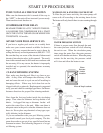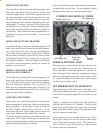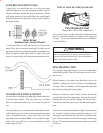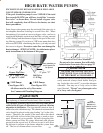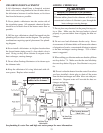
FILTER CLEANING & CARE
Your filter system should be cleaned at least twice a
month. See manufacturer's directions for proper filter
cleaning methods. Size and conditions may require you
to clean the filter more often. A filter is considered
"dirty", whenever it restricts the flow rate by 10% or
more.
You can use the pressure gauge on the filter tank to de-
termine a restriction in the filter due to clogging. After
the filter has been replaced or when it is new, you should
record the actual operating pressure with a "clean fil-
ter". When the pressure increases more than 5 p.s.i.,
the filter should be cleaned. If the pressure does not
return to normal you must replace it. Make sure your
pressure gauge is kept in good working condition.
There are some after market filter element cleaning so-
lutions that will help remove oil and minerals that may
clog the filter. Oil and minerals can not be removed
with normal cleaning and back-washing. Spas are par-
ticularly susceptible to oil build up in the filter. Do not
acid wash a filter until you have removed all oil and
grease with a solution designed to remove such. Acid
washing a filter with oil in it will cause that oil to be-
come permanently embedded in the fibers. Cartridge
filter element replacement is suggested every 1 to 2
years. Sand filters should have the sand replaced every
3 to 5 years. D.E. type filter elements should be re-
moved and soaked in a solution at least every two years.
WATER FLOW
Proper water flow is critical to the heaters performance
and longevity. The maintenance of your filtering sys-
tem is directly related to the proper operation of the
heat pump. See pages 8 for other information regarding
filter cleaning and the start up procedures.
CIRCULATION PUMP
The circulation pump must be kept in good working
order to provide a steady rate of flow to the heater and
filtering system as a whole. The circulation pump must
be producing a flow rate in accordance with the manu-
facturers specifications within 10%. The pump should
run with a "full prime" without excessive restriction on
the vacuum and pressure side of the filtering system.
VACUUM & PRESSURE LEAKS
All vacuum and pressure leaks in the filtering system
must be eliminated immediately after occurring. Air
allowed into the filter system from the vacuum side of
the circulation pump will cause premature wear and
physical erosion to the heat exchanger and water pip-
ing inside the heater. Air turbulence will cause the wa-
ter pressure switch to malfunction.
Pressure leaks on the filtering system will allow the sys-
tem to lose vacuum and cause the water in the filter and
piping to back siphon or reverse flow through the sys-
tem when the circulation pump is off. Reverse flow
may cause the water pressure switch to malfunction.
CHLORINATORS
See chlorinator placement and chemical use guide-
lines.
FILTER SYSTEM MAINTENANCE REQUIREMENTS
Air Bleed
Valve
PSI
Gauge
Locking Nut &
O-Ring
O-Ring
Element
Filter Tank
Typical
Cartridge
Filter
Inlet
Outlet
Pump Lid
"Suction"
Inlet
Electric
Motor
Lint Trap
Discharge Outlet
"Pressure"
Impeller
Housing
Typical Circulation Pump
16



